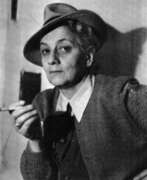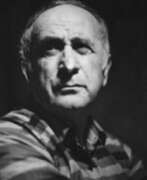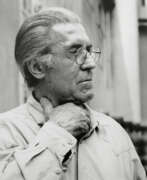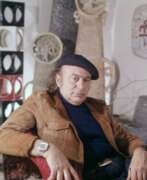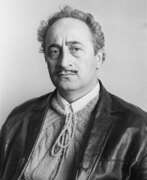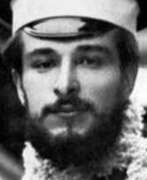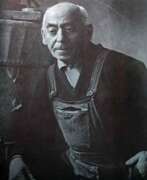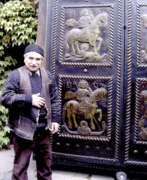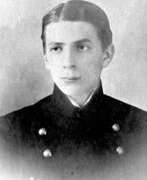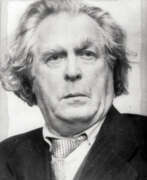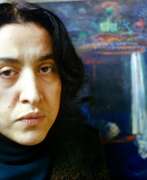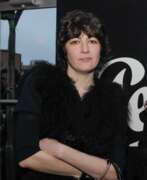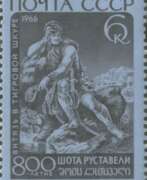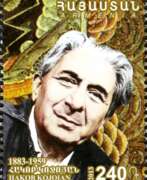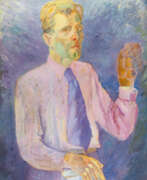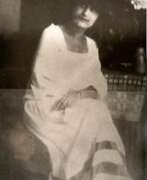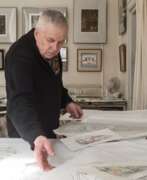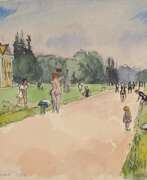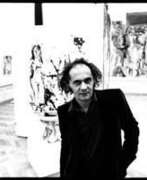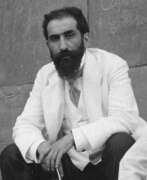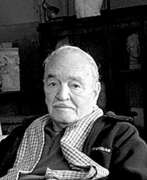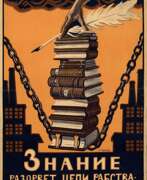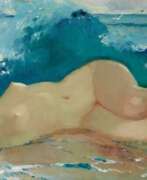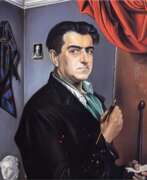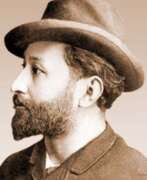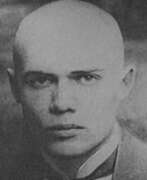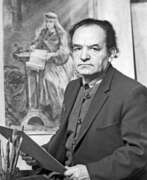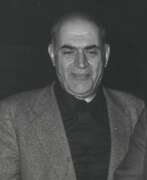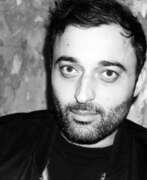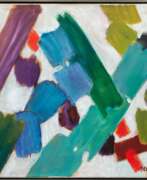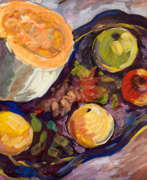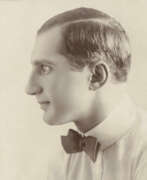Georgia
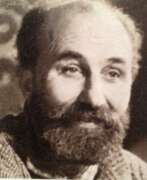

Eduard Georgievich Bragovsky (Russian: Эдуард Георгиевич Браговский) was a Soviet and Russian artist of the second half of the twentieth and early twenty-first centuries. He is known as a painter who specialized in the genres of landscape, portrait and still life.
Eduard Bragovsky closely connected his creative destiny with the Russian town of Tarusa, where he lived for several years. He painted many paintings, creating a "portrait" of the town. The artist actively traveled around the country, creating works from nature. His works were exhibited in various museums in Russia, the CIS and other countries, as well as at personal exhibitions in different parts of the world.
He actively participated in the work of the Moscow Union of Artists, was a member of the Board, headed the painting section.
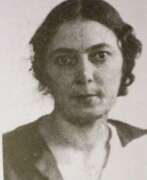

Natalya Yakovlevna Danko (Russian: Наталья Яковлевна Данько) was a distinguished Russian sculptor and medallist, celebrated for her profound contributions to the world of porcelain art. Born in 1892 and passing in 1942, Danko's journey in art commenced with rigorous training in Moscow at the Stroganov School and the City Art School, eventually leading her to significant roles in the Imperial Porcelain Factory. By 1914, she was working under the guidance of Vasiliy Lebedev, and by 1919, Danko had risen to the head of the sculpture workshop, a position she held until 1941.
Danko's oeuvre is characterized by its revolutionary spirit and exquisite craftsmanship, particularly noted in pieces like the "Red Army Soldier" (1919) and her iconic "Revolutionary chess set" (1922), which have earned her international acclaim. Her innovative designs not only reflected the political changes of her time but also showcased her mastery over porcelain, bringing a new dimension to Soviet art. Her works were showcased globally, from Paris to Monza, cementing her legacy in the international art scene.
Among her most celebrated works are the "The Reds and the Whites chess set" (1922-1932) and "Woman and Child with Fish" (1922-1923), both masterpieces of glazed and hard-paste porcelain, respectively. These pieces, housed in prestigious institutions like the Cooper Hewitt, Smithsonian Design Museum, and the Clark Art Institute, exemplify Danko's skill in blending artistic expression with social commentary, making her an important figure in both Russian and global art history.
For collectors and art and antiques experts, Danko's legacy represents a fascinating intersection of artistic innovation and historical narrative. Her works not only adorn museums but also continue to influence contemporary porcelain art, making her an enduring figure of interest.
To stay updated on sales and auction events related to Natalya Yakovlevna Danko's works, consider signing up for updates. This subscription will ensure you're informed about new opportunities to acquire pieces by this remarkable artist, connecting you directly to the rich history and ongoing legacy of Danko's contributions to art.
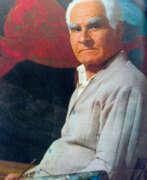

Lado Gudiashvili (Russian: Ладо Давидович Гудиашвили) was a Georgian artist, celebrated for his distinctive and innovative contributions to 20th-century art. Born in Tbilisi, Gudiashvili embarked on his artistic journey at the Tbilisi school of sculpture and fine art, later enhancing his skills in Paris's Ronson's private academy. His work, deeply influenced by Georgian life and culture, masterfully blends dramatic grotesque with poetic mystery, often incorporating elements of Caucasian and Persian traditions.
Gudiashvili's artistic repertoire was vast, encompassing painting, book design, graphic art, and teaching. He was an integral part of the Tbilisi Modernism and Socialist Realism periods, contributing significantly over a 60-year career. His engagement with avant-garde circles in Tbilisi and his murals for popular cafes showcased his versatility and creativity. Gudiashvili's Paris years (1919-1926) were marked by independence and recognition, as he exhibited alongside notable contemporaries and was encouraged to showcase his work independently.
His contributions were not limited to canvas; Gudiashvili also left an indelible mark on set design and book illustration, working on productions and literary classics that remain influential. Notably, his works adorn the Kashveti Church in Tbilisi, a testament to his monumental talent. Despite facing challenges, including political pushback for his church paintings, Gudiashvili's legacy as a pioneering Georgian artist remains undisputed. He received several high Soviet honors, underscoring his significance in the art world.
For collectors and experts in art and antiques, Gudiashvili represents a vital link between Georgian cultural heritage and modernist expressions. His works, which include engaging illustrations, set designs, and captivating paintings, continue to attract interest for their historical significance and artistic value.
To stay updated on sales and auction events featuring Gudiashvili's works, sign up for updates. This subscription will ensure you're informed about opportunities to acquire pieces by this remarkable Georgian artist.


George Guraspaschvili is a Georgian painter and sculptor, professor at the Georgian State Academy of Art in Tbilisi, and member of the Union of Artists of the USSR. Since the mid-1990s his works have been exhibited internationally, particularly in Germany and China.
Guraspashvili has won numerous awards, including the Gold Medal for watercolor at the Malta Biennale. He is actively engaged in the promotion of young, talented artists from the Caucasus.
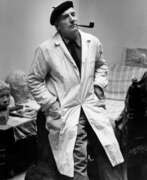

Stanisław Horno-Poplawski was a Polish sculptor, artist and teacher.
In the late 1910s, young Stanisław became interested in painting and art in Moscow, where his family moved from Georgia, then continued his studies at the Warsaw School of Fine Arts. Stanisław Gorno-Poplawski made the subject of his sculpture a rough field stone, giving it the features of famous and unknown Poles' faces, creating compositions filled with life. His works can be seen in many museums in Poland and the world.


Ucha Malakievich Japaridze (Russian: Уча Малакиевич Джапаридзе) was a prominent Soviet and Georgian painter, born on August 17, 1906, in the village of Gari, Georgia. His life and work significantly contributed to the development of 20th-century Georgian visual arts, making him a key figure in this field. Japaridze's artistic journey was marked by his dedication to capturing the essence of Georgian heritage and the people's historical past through his paintings, including detailed portraits, monumental wall paintings, and book illustrations.
Throughout his career, Japaridze was recognized with numerous awards, reflecting his importance and contribution to the arts in Georgia. He held prestigious titles such as Public Artist of the Georgian SSR and Honored Artist of Georgia. His role as an academician at the Georgian Academy of Arts and his tenure as chancellor at the Tbilisi State Academy of Arts were testament to his influence and leadership in the artistic community.
Japaridze's works are celebrated for their variety and technical mastery, covering diverse fields and themes that resonated with the significant events of his time. His legacy continues to be preserved in several museums and private collections both in Georgia and internationally, including the Georgian National Museum of Fine Arts and the National Gallery of Georgia. Notably, his former home in Tbilisi has been transformed into a museum, housing his paintings, graphics, and documentary materials, offering insight into his life and artistic achievements.
For collectors and art experts interested in Soviet and Georgian visual arts, Japaridze's oeuvre represents a critical link to the cultural and historical narrative of Georgia. His ability to intertwine the personal with the collective experience of his homeland offers a profound perspective on the artistic movements of his time.
To stay informed on updates and opportunities related to Ucha Malakievich Japaridze's works, including sales and auction events, sign up for updates. This subscription ensures you're always in the loop regarding new discoveries and collections featuring Japaridze's art.
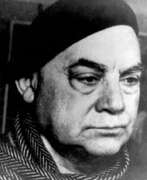

Iosif Artemievich Karalyan was a Soviet artist, member of the USSR Union of Artists and Honoured Artist of the Armenian SSR.
Karalyan's creative work is a kind of nostalgia for the country of childhood, which you can visit only in dreams and imagination, as it no longer exists, because childhood of every person, like his era, is unique, the unrepeatable sensations experienced, they are preserved visually only in the fine arts.
His works are kept in the Museum of Modern Art (Yerevan), National Gallery of Armenia (Yerevan), State Tretyakov Gallery (Moscow), Museum of Oriental Art (Moscow), home-museum of Hovhannes Tumanyan (Yerevan), the funds of the Ministry of Culture of Armenia and numerous private collections in Armenia and abroad.
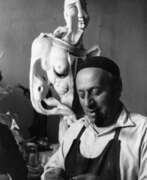

Yervand Kochar (Russian: Ерванд Семёнович Кочар) was an Armenian sculptor and modern artist, renowned for his groundbreaking contributions to the 20th-century art world, particularly as a pioneer of the Painting in Space art movement. Born in Tbilisi, Georgia, in 1899, Kochar's artistic journey led him from his native land to Paris, where his innovative works earned him critical acclaim and a place alongside other avant-garde artists. His creations, characterized by a dynamic blend of sculpture and painting, sought to introduce time as a fourth dimension to art, presenting a novel way of perceiving artistic expressions.
Kochar's most celebrated works, such as the statues of David of Sassoun and Vardan Mamikonian, have become emblematic of Armenian heritage, symbolizing the enduring spirit and cultural richness of Armenia. His masterpiece in painting, "Disasters of War," alongside other significant works, underscores his versatility and mastery over different mediums. The Yervand Kochar Museum in Yerevan, Armenia, serves as a testament to his enduring legacy, housing a vast collection of his works and offering insights into his artistic evolution and the profound impact of his contributions to modern art.
For art collectors and experts, Kochar's work represents not only a pivotal moment in the history of modern art but also an opportunity to engage with the rich tapestry of Armenian cultural identity. His innovative approach to form, space, and time continues to inspire new generations of artists and art aficionados worldwide.
To stay updated on exhibitions and auctions featuring Yervand Kochar's works, sign up for updates. By subscribing, you'll receive alerts on new sales and auction events related to Kochar's art, ensuring you never miss an opportunity to engage with the legacy of this remarkable artist.
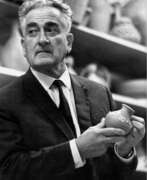

Apollon Karamanovich Kutateladze (Russian: Аполлон Караманович Кутателадзе) was a distinguished Soviet and Georgian artist, celebrated for his contributions to painting, graphic design, and pedagogy. Born in Georgia, Kutateladze's journey in art began at a young age, leading him to study under notable figures such as Eugene Lanceray, Gigo Gabashvili, and Iosif Adolfovich Charlemagne at the Tbilisi State Academy of Arts. His education was enriched by academic trips, including those to Leningrad, which broadened his artistic perspective.
Kutateladze's career was marked by a significant shift in teaching methodology at the Tbilisi State Academy of Arts, where he served as rector from 1959. Inspired by the principles of Walter Gropius and the Bauhaus, he introduced a new pedagogical approach that emphasized practical work and collaboration with industrial partners, moving away from classical art education methods. This innovative approach left a lasting impact on the academy, which was later renamed in his honor.
Throughout his lifetime, Kutateladze received numerous accolades, including the title of People's Artist of the USSR, and was awarded prestigious orders such as the Order of the Badge of Honour and the Order of the Red Banner of Labour. His works, which include a vast array of historical scenes and portraits, reflect a deep engagement with the cultural and political landscapes of his time. Notable works include "Comrade Stalin heading the Batumi workers' protest," "Conversation between comrade Stalin and the peasants of Adjara in 1902," and "March of Queen Tamara".
For collectors and experts in art and antiques, Kutateladze's legacy offers a rich tapestry of Soviet and Georgian art history, characterized by its pedagogical innovation and profound thematic depth. His works continue to be celebrated and studied, offering insights into the artistic movements and cultural dynamics of his era.
For more details and updates related to Apollon Karamanovich Kutateladze, including sales and auction events, signing up for updates is highly recommended. This subscription ensures that enthusiasts and collectors are always informed about the latest developments and opportunities related to Kutateladze's remarkable body of work.


Dmitry Arkadievich Nalbandyan (Russian: Дмитрий Аркадьевич Налбандян) was a Soviet and Armenian painter, whose work earned him significant recognition including the Stalin Prize and the title of People's Artist of the USSR. Born in Tiflis (now Tbilisi, Georgia) in 1906 and passing away in Moscow in 1993, Nalbandyan's contributions to the art world were profound, spanning across genres such as portraiture, landscape, and political art. His education began in Moisei Toidze’s art studio and continued at the Academy of Arts in Tiflis, laying the foundation for a career that would see his works displayed in some of the most prestigious museums globally, including the State Tretyakov Gallery and the Uffizi Gallery in Florence.
Nalbandyan’s art was deeply intertwined with the political and social fabric of his time, with several of his works focusing on significant political figures and moments in Soviet history. For example, his portrait of Joseph Stalin and his depiction of Lenin speaking on the Red Square are indicative of his engagement with the political climate of the USSR. His artworks, characterized by their realism and attention to detail, have been celebrated for capturing the essence of their subjects and the spirit of an era. Notably, Nalbandyan was awarded not only for specific portraits but also for contributions to exhibitions and for paintings that reflected the ethos of friendship, peace, and Soviet achievements.
His artistic legacy is preserved through his contributions to major exhibitions and his inclusion in the collections of museums such as the Russian Museum, highlighting works like "At the Crimea Conference" and "For the Happiness of the People". These pieces, along with others like "Lenin speaking on the Red Square in 1919," underscore Nalbandyan’s role in documenting and interpreting Soviet history through art.
For collectors and experts in art and antiques, Nalbandyan's works offer a window into the Soviet era's visual culture, embodying the aesthetics, ideologies, and historical moments of the time. His paintings, whether they depict political leaders, scenic landscapes, or everyday life, continue to attract attention for their historical significance and artistic merit.
To stay updated on exhibitions, sales, and auctions featuring Dmitry Arkadievich Nalbandyan's art, signing up for updates can provide enthusiasts and collectors with timely information on opportunities to engage with his work. This subscription is an essential tool for those interested in Soviet-era art, offering insights and access to the remarkable legacy of one of the era's most significant artists.
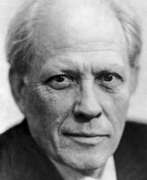

Yuri Mikhailovich Neprintsev (Russian: Ю́рий Миха́йлович Непри́нцев) was a celebrated Soviet and Russian painter, a distinguished member of the Academy of Arts of the USSR, and a professor at the Repin Institute of Arts. Born in 1909, Neprintsev's work is a vivid representation of Soviet life, encapsulating moments of history with a profound sense of realism and emotional depth. His participation in World War II as a volunteer not only influenced his thematic focus but also lent a genuine authenticity to his depictions of battle and everyday heroism.
Neprintsev's most renowned painting, "Rest after the battle," earned him the prestigious Stalin Prize in 1952. This work, along with others like "The Last Grenade" and "The Story of the Father," are poignant narratives of the Soviet spirit during trying times. His early works, such as “Conclusion of a contract for socialist competition,” created in 1939, showcased his ability to capture life's unscripted moments, portraying them with an immediacy that engages the viewer directly.
Over his long and storied career, Neprintsev was honored with numerous awards, including the Order of the Red Star, the Order of Lenin, and the title of People's Artist of the USSR. His paintings are held in prestigious collections worldwide, including the State Russian Museum and the State Tretyakov Gallery, reflecting his significant impact on Russian and Soviet art.
Neprintsev's legacy extends beyond his own creations; he was a dedicated teacher, shaping the next generation of artists at the Repin Institute of Fine Arts from 1948 until his passing in 1996. His influence on students like LA Rusov and E. V. Kozlov underscores his role in perpetuating the rich tradition of Russian painting.
For collectors and art enthusiasts interested in exploring the depth and breadth of Soviet-era art, Yuri Mikhailovich Neprintsev's work offers a compelling narrative of resilience, beauty, and the human spirit under the pressures of war and societal change. Sign up for updates on new product sales and auction events related to Yuri Mikhailovich Neprintsev, and discover more about this remarkable artist whose work continues to inspire and resonate across generations.


Niko Pirosmani was a Georgian primitivist painter, known for his unique approach to art, marked by simplicity and directness. Born in 1862 in the village of Mirzaani, Georgia, Pirosmani was largely self-taught, developing his skills through his work as a signboard painter. His early life was marked by hardship; orphaned at a young age, he took on various jobs, such as a railroad conductor and dairy farm co-founder, to sustain himself. Despite his financial struggles, Pirosmani's dedication to painting persisted.
Pirosmani's work, characterized by its naïve style, often depicted rural life, animals, and historical Georgian figures. His medium of choice was typically oilcloth, and he preferred frontal placements of figures and monochromatic palettes. His work gained posthumous fame, influencing the Russian avant-garde. Pirosmani's life, filled with both adversity and creative triumph, ended in 1918 due to malnutrition and liver failure, leaving behind a legacy that continues to resonate within the art world.
One of his notable works, "Wedding in the Old-Times Georgia" (1916), showcases his appreciation for Georgian customs and is considered a turning point in his career. Another significant piece, "Portrait of Ilya Zdanevich" (1913), exemplifies his style and the influence of his meeting with the Zdanevich brothers, which brought his art to a wider audience. Pirosmani's paintings are housed in institutions like the Art Museum of Georgia in Tbilisi, reflecting his enduring impact on Georgian culture.
Collectors, auctioneers, and art experts continue to revere Pirosmani's work for its raw and emotive power. His pieces, once overlooked, now fetch high prices at auctions and are studied for their cultural and historical significance. For those interested in Pirosmani's art and legacy, updates on new product sales and auction events related to his work are available through subscription. This service provides enthusiasts with timely information, ensuring they don't miss out on the opportunity to engage with the profound artistry of Niko Pirosmani.
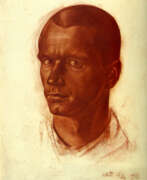

Vasily Ivanovich Shukhaev (Russian: Василий Иванович Шухаев) was a multifaceted Russian and Soviet artist, celebrated for his expertise as a painter, graphic artist, stage designer, and teacher. Born in Moscow in 1887, Shukhaev's artistic journey began at the Imperial Stroganov School of Industrial Art, where he was under the tutelage of prominent artists like K. A. Korovin and I. I. Nivinsky. His education continued at the St. Petersburg Academy of Arts, which paved the way for his diverse and influential career. Shukhaev's body of work is vast, encompassing hundreds of paintings, drawings, theater sketches, book illustrations, and monumental works, showcasing a deep engagement with genre paintings, still lifes, landscapes, and portraits.
Shukhaev's legacy includes a significant period of creativity and teaching in Paris in the early 20th century, after leaving Russia post-October Revolution. His Parisian phase was marked by innovative book illustrations for renowned literary works by Pushkin, Gogol, Dostoevsky, and others, demonstrating his unique ability to blend literary themes with visual artistry. Notably, his illustrations for Pushkin's "Queen of Spades" and "Boris Godunov" stood out for their stylistic nod to vintage prints and the emblematic use of symbols.
His art has been celebrated in various international exhibitions and is held in high regard by collectors and museums alike. Works such as "The Reigning Monarchs of the World" (1934), a group caricature published in Vanity Fair, reflect Shukhaev's versatile style and ability to capture the essence of his subjects with a mix of reverence and subtle critique.
For art collectors and enthusiasts interested in Russian and Soviet art, Vasily Ivanovich Shukhaev's oeuvre represents a bridge between classical traditions and modern artistic expressions. His work continues to captivate audiences with its historical depth, technical brilliance, and emotive power.
If you're keen on exploring more about Vasily Ivanovich Shukhaev's works or wish to stay updated on sales and auction events featuring his art, signing up for updates is a step towards immersing yourself in the rich tapestry of Russian art history.


Tamuna Sirbiladze was an artist based in Vienna, Austria. She studied art at the Tbilisi State Academy of Arts (1989–1994) in Georgia and later the Academy of Fine Arts Vienna (1997–2003) and Slade School of Fine Art, London, 2003.


Moses Ivanovich Toidze (Russian: Моисей Иванович Тоидзе) was a distinguished Georgian Soviet artist and educator, known for his significant impact on art during the early to mid-20th century. Born and passed away in Tbilisi (February 2, 1871 - June 17, 1953), his life and work mirrored the substantial cultural shifts of his time. His contributions spanned various genres, including genre art, historical painting, landscape painting, and portraiture, showcasing his versatility and deep connection to the Georgian cultural identity.
Toidze's career was also marked by his dedication to art education. As a professor at the Tbilisi Academy of Arts and the founder of a public art studio in Tbilisi in 1922, he played a pivotal role in establishing the foundations of professional art education in Georgia. This commitment to nurturing talent influenced countless Georgian artists, enriching the nation's artistic heritage.
His body of work reflects a profound engagement with Georgian life, capturing its landscapes and people with emotional depth and nationalistic pride. Notable works like "Market (Bazazkhana)" (1914), "Landscape" (1918), and "King Tamar in the Country-Cottage" (1919) exemplify his skill in blending realism with emotive storytelling.
Preserving Toidze's legacy, the Mose Toidze House Museum, established in his former home and studio, curates a vast collection of his artworks alongside photographic and documentary materials. This museum offers a comprehensive look into his life, work, and the cultural backdrop that influenced him.
For art collectors and experts, Moses Ivanovich Toidze remains a central figure in modern Georgian painting, whose work and influence persist in inspiring current and future generations. Staying informed about sales and auction events related to Toidze's work is essential for those looking to immerse themselves in or acquire pieces of this master's enduring legacy.
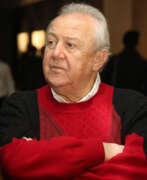

Zurab Konstantinovich Tsereteli (Russian: Зураб Константинович Церетели), a Georgian-Russian artist renowned for his monumental sculptures, has left an indelible mark on the landscape of modern art. Born in Tbilisi in 1934, Tsereteli expanded his artistic vision beyond painting after moving to Paris in the 1960s, where he was influenced by luminaries such as Picasso and Chagall. His work is characterized by a blend of dramatic, unconventional styles that have spurred debate but undeniably contributed to the cultural fabric of cities around the world.
Tsereteli's artworks, ranging from sculptures to paintings, are displayed globally, embodying his ethos that "art unites people." Noteworthy projects include the Peter the Great statue in Moscow, the Birth of the New Man in Seville, Spain, and the Tear of Grief in Bayonne, New Jersey, a poignant memorial to the victims of the 9/11 attacks. His commitment to fostering international cultural exchanges is evident in his role as the President of the Russian Academy of Arts and a UNESCO Goodwill Ambassador.
Beyond his public commissions, Tsereteli's contributions to education and the arts are profound. He founded the Moscow Museum of Modern Art and the Museum of Modern Art in Tbilisi, promoting modern and contemporary art in Russia and Georgia. His dedication to the Russian Academy of Arts underscores his belief in the importance of nurturing artistic talent and preserving the heritage of the academic school of fine arts.
For collectors and experts in art and antiques, Tsereteli's oeuvre offers a unique investment in pieces that are not only visually striking but also rich with cultural significance. His work encapsulates the dynamic interplay between traditional and contemporary art forms, making each piece a testament to his lifelong dedication to artistic innovation and cross-cultural dialogue.
To stay updated on new exhibitions, sales, and auction events related to Zurab Konstantinovich Tsereteli, sign up for updates. This subscription is a gateway to the latest developments in the world of a towering figure in art, offering exclusive insights into his ongoing contributions to the global art scene.
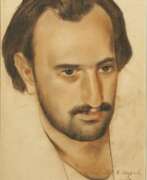

Alexei Ivanovich Vepkhvadze (Russian: Алексей Иванович Вепхвадзе) was a Soviet and Georgian artist of the second half of the twentieth century. He is known as a graphic artist, painter, poster artist, Honored Artist of the Georgian SSR.
Alexei Vepkhvadze worked in a variety of genres, including historical and genre painting, portraits and book graphics. He was a recipient of the Stalin Prize of the third degree. Among his most famous works are "Portrait of a Wife", "Bagration's Wounding", "Portrait of Mother", "Vazha-Pshavela", "Stalin's Expulsion from Batum in 1903", and "Shota Rustaveli Reading His Poem".
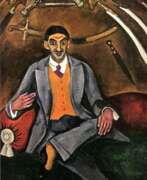

Georgy Bogdanovich Yakulov (Russian: Гео́ргий Богда́нович Яку́лов) was a multifaceted Armenian artist renowned for his contributions across several artistic domains, including painting, graphic art, stage design, and art theory. Born on January 16, 1884, in Tiflis (now Tbilisi), Yakulov's work is celebrated for its abstract art and avant-garde approach, blending Eastern influences with European modernism. His art is notable for its abstract qualities, rich decorative colors, and a unique blend of romantic expressionism with a fascination for Oriental exoticism.
Yakulov's journey into the art world was marked by significant milestones, such as his studies at the Moscow School of Painting, Sculpture and Architecture, and his military service in northeast China, which introduced him to Eastern light effects and decoration. His artistic career flourished with exhibitions across Moscow, Paris, and Berlin, where he became associated with notable movements and figures, including the Delaunays and their theory of Simultanism.
A pivotal moment in Yakulov's career was his contribution to theatre, most notably his work with the Moscow Chamber Theatre and his designs for ballets, including those commissioned by Diaghilev for the Ballets Russes. This period highlighted his ability to merge traditional theatrical techniques with modernist abstraction, creating a lasting impact on stage design.
His theories, particularly the "Theory of Colored Suns," showcased his innovative approach to art, emphasizing the importance of light and color, which he explored through his essays and designs. Despite his passing on December 28, 1928, Yakulov's legacy endures through his contributions to modern art and theatre, with works displayed in notable galleries and a special place among avant-garde artists.
For art collectors and enthusiasts interested in exploring the rich tapestry of Eastern and European avant-garde movements, Georgy Bogdanovich Yakulov's work represents a fascinating convergence of cultures and artistic philosophies. To stay updated on new discoveries and exhibitions related to Yakulov, consider signing up for updates. This will ensure you're always informed about sales and auction events celebrating his remarkable legacy.
